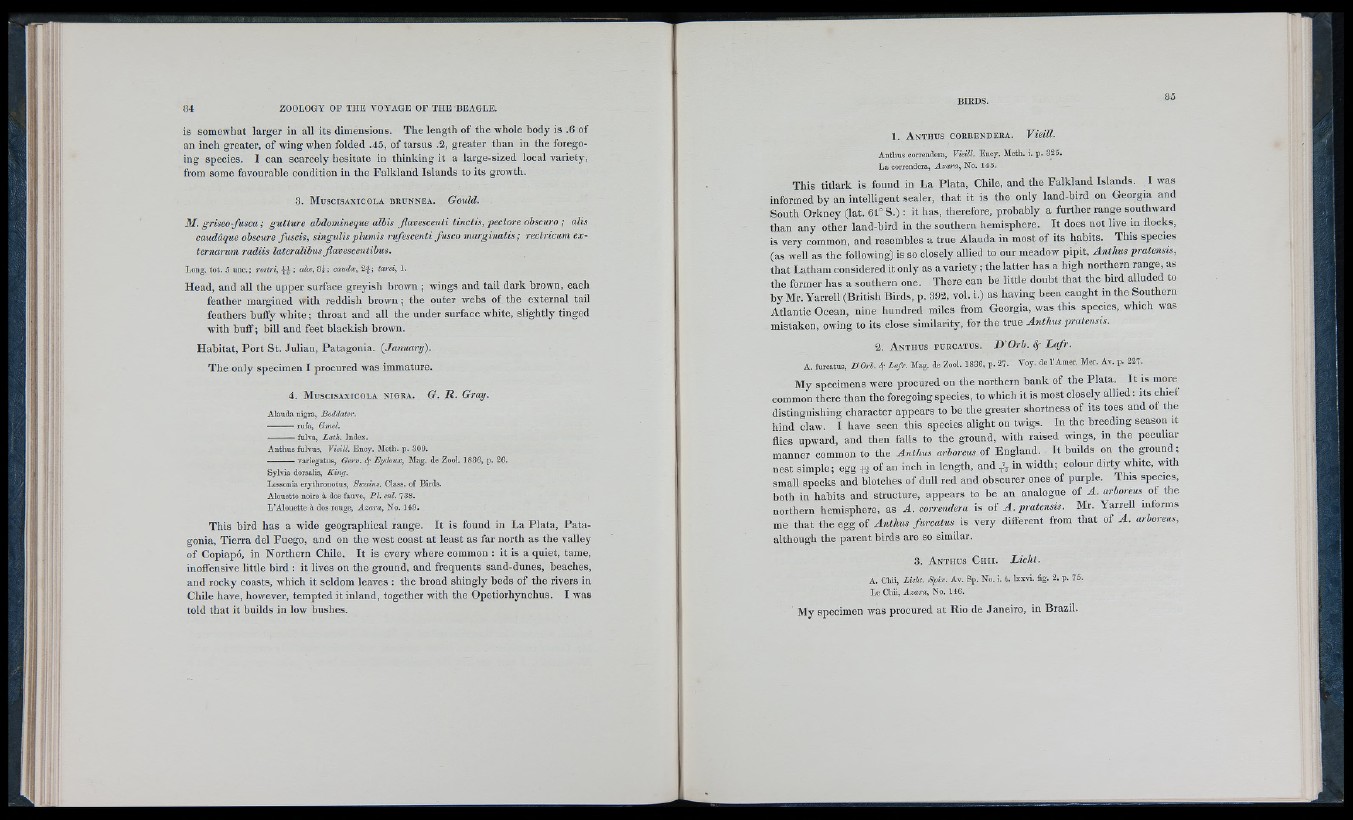
is somewhat larger in all its dimensions. The length of the whole body is .6 oi
an inch greater, of wing when folded .45, of tarsus .2, greater than in the foregoing
species. I can scarcely hesitate in thinking it a large-sized local variety,
from some favourable condition in the Falkland Islands to its growth.
3 . M u s c i s a x ic o l a b r u n n e a . Gould.
31. griseo-fusca ; gutture abdomineque albis fiavescenti tinctis, pectore ohscuro ; alis
caudâque obscure fuscis, singulis plumis rufescenti fusco marginatis; rectricum externarum
radiis lateralibus flavescentibus.
Long. tot. 5 unc.; rostri, ; aloe, 3 i ; caudæ, 2-|; tarsi, 1.
Head, and all the upper surface greyish brown ; wings and tail dark brown, each
feather margined with reddish brown ; the outer webs of the external tail
feathers buffy white ; throat and all the under surface white, slightly tinged
with buff ; bill and feet blackish brown.
Habitat, Port St. Julian, Patagonia. (January).
The only specimen I procured was immature.
4 . M u s c i s a x ic o l a n i g r a . G. R . Gray.
Alauda nigra, Boddater.
- fulva, Lath. Index.
Anthus fulvus, Vieill. Ency. Meth. p. 309.
----------variegatus, Gerv. 4" Bydoux, Mag. de Zool. 1836, p. 26.
Sylvia dorsalis, King.
Lessonia erythronotus, Sicains. Class, of Birds.
Alouette noire á dos fauve, PI. enl. 738.
L ’Alouette á dos rouge, Azara, No. 149.
This bird has a wide geographical range. It is found in La Plata, Patagonia,
Tierra del Fuego, and on the west coast at least as far north as the valley
of Copiapó, in Northern Chile. It is every where common : it is a quiet, tame,
inoffensive little bird : it lives on the ground, and frequents sand-dunes, beaches,
and rocky coasts, which it seldom leaves : the broad shingly beds of the rivers in
Chile have, however, tempted it inland, together with the Opetiorhynchus. I was
told that it builds in low bushes.
1 . A n t h u s c o r r e n d e r a . Vieill.
Anthus correndera, Vieill. Ency. Meth. i. p. 325.
La correndera, Azara, No. 145.
This titlark is found in La Plata. Chile, and the Falkland Islands. I was
informed by an intelligent sealer, that it is the only land-bird on Georgia and
South Orkney (lat. 61° S . ) : it has, therefore, probably a further range southward
than any other land-hird in the southern hemisphere. It does not live m flocks,
is very common, and resembles a true Alauda in most of its habits. This species
(as well as the following) is so closely allied to our meadow pipit, Anthus pratensis,
that Latham considered it only as a variety; the latter has a high northern range, as
the former has a southern one. There can he little doubt that the bird alluded to
by Mr. Varrell (British Birds, p. 392, vol. i.) as having been caught m the Southern
Atlantic Ocean, nine hundred miles from Georgia, was this species, which was
mistaken, owing to its close similarity, for the true Anthus pratensis.
2 . A n t h u s f u r c a t u s . D'Orb. Sg Lafr.
A. furcatus, D'Orh. Sf Lafr. Mag. de Zool. 1836, p. 27. Voy. de TAmer. Mer. Av. p. 227-
My specimens were procured on the northern bank of the Plata. It is more
common there than the foregoing species, to which it is most closely allied: its chief
distinguishing character appears to be the greater shortness of its toes and of the
hind claw. I have seen this species alight on twigs. In the breeding season it
flies upward, and then falls to the ground, with raised wmgs, in the peculiar
manner common to the Anthus arboreus of England. It builds on the ground ;
nest simple; egg qj of an inch in length, and j , in width; colour dirty white, with
small specks and blotches of dull red and obscurer ones of purple. This species,
both in habits and structure, appears to be an analogue of A . arhoreus of the
northern hemisphere, as A . correndera is of A . pratensis. Mr. Yarrell informs
me that the egg of Anthus furcatus is very different from that of A . arboreus,
although the parent birds are so similar.
3 . A n t h u s Chii. Licht.
A. Chii, Licht. Splc. Av. Sp. No. i. t. Ixxvi. fig. 2. p. 75.
Le Chii, Azara, No. 146.
My specimen was procured at Rio de Janeiro, in Brazil.